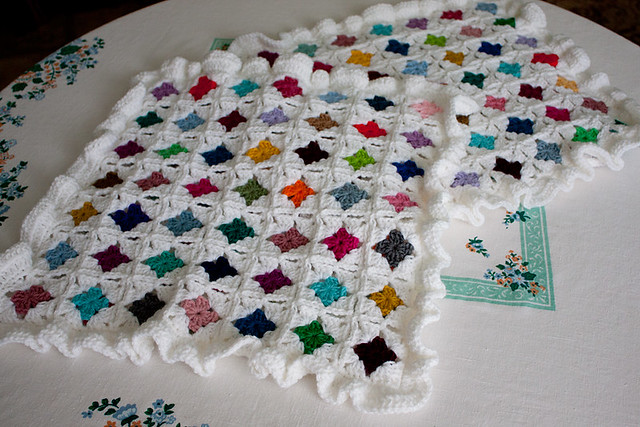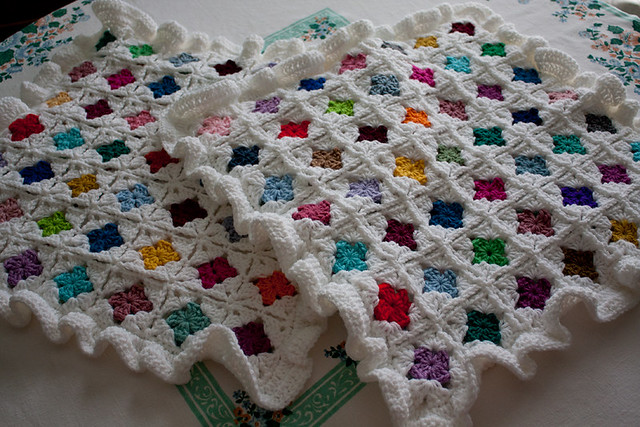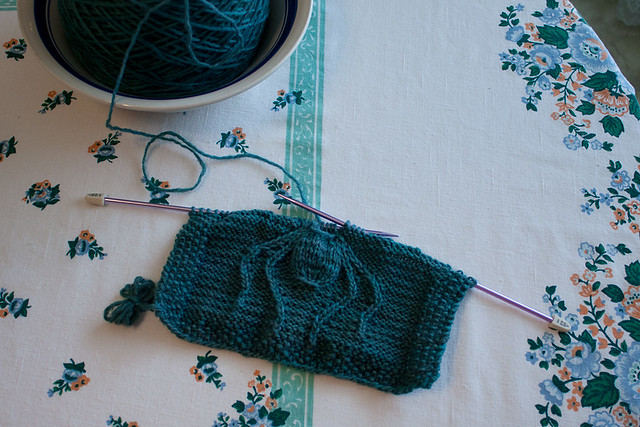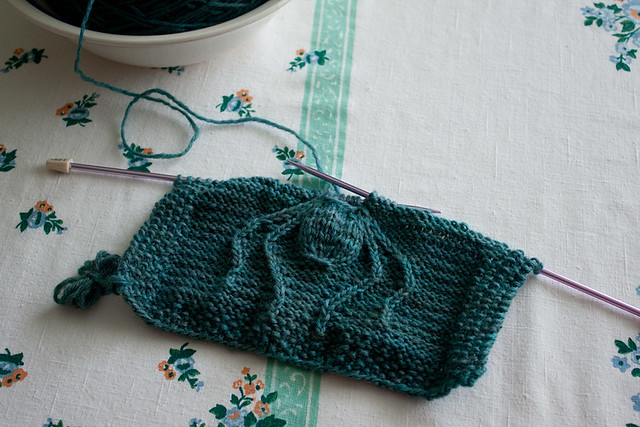Sorry, still no photos of anything that was awaiting blocking (because blocking hasn't happened), but here are a couple of photos of the finished (but not washed) crocheted pillow covers. The pillow inserts aren't yet in existence, so it's just the covers by themselves.
I ended up only doing part of the ruffled edging, because I was afraid the yarn wouldn't hold out through the final round. Fortunately, I think it looks good even without the last round. (Otherwise, some other white acrylic would probably work fine in substitution.)
Looking through my Ravelry queue (which is way too long and should be pared down), I came across a pattern I'd completely forgotten: "October is for Spinners".
It's kind of an odd-looking knitted scarf. You start out normally enough, though the motif (the spider from Barbara Walker's Third Treasury of Knitting Patterns) is perhaps a bit unusual for some of us. Things only get weirder from there. A few "holes" dot the fabric, and the further along you go, the bigger the holes get. By the time you've reached the other end of the scarf, it's practically in tatters, with a definite spider web vibe.
I have no idea if this is the kind of thing I will ever actually use, but it appealed to me enough that I queued it, and it stopped me in my tracks when I rediscovered it there. Strange as it is, I find it fascinating, and since I'm eagerly anticipating October (spider season), it seemed like the perfect time to try knitting it.
Now, the pattern calls for laceweight. You start out holding four strands together, then gradually drop them (and switch up to progressively larger needles) as the scarf "deteriorates". I love the look, but I don't have enough yardage of any single color to knit it in laceweight. I didn't want to wait for new yarn to be shipped-- and honestly, I'd rather not spend money on yarn right now, anyway, when I have a perfectly good little stash already-- so I'm following the example of a few other Ravellers and trying my hand at converting the pattern for worsted weight.
As far as I've seen, there are no full "translations" of the pattern for worsted weight. Most people seem to have just worked the whole thing with a single strand of yarn and one needle size. That's what I plan to do.
For the first part of the scarf, you just knit according to the pattern. The tricky part comes later. If I understand correctly, the pattern's stitch count decreases as you swap up to larger needles. I don't know how that will work out with worsted weight-- probably not very well. If nothing else, you can wing it. You just have to be sure that the stitches you drop (to create the strategically placed holes) have something (a k2tog? I'm not completely clear on that, yet) below them to stop the dropped stitch from just running (opening up) all the way down the scarf. (ETA: I think you need to be sure there's a YO below a stitch to stop it from running, though it seems fairly common for a k2tog to be next to a YO, probably to help shape/widen the hole while maintaining a more-or-less even stitch count.)
...I think this will be a learning experience! (g)
I'm still in the spider section, and I'm surprised by how enjoyable it's been! I never would've thought this type of knitting could be so entertaining. It's a little like a doily in that every row (or round, in the case of most doilies) is different, so it keeps you on your toes, but whereas doily rounds can be painfully slow to complete (as they grow and grow in size), each row of this spider is fairly quick to do.
Pattern:
October is for Spinners (free on Ravelry)
Yarn:
Lion Brand Fishermen's Wool
I started with "Natural" (cream/undyed) and used food coloring (Wilton's gel) and vinegar to dye it into a blue-green semi-solid. (I used this method of dyeing. Here's my blog post about this particular dye job, from over a year ago.) I think the bottom photo is probably closer to the true color. Many more photos will follow, when it's finished (whenever that may be).
Incidentally, Ravelry has Fishermen's Wool listed as aran weight-- not worsted. Fortunately, it's a scarf, so gauge won't matter one way or the other.
I ended up only doing part of the ruffled edging, because I was afraid the yarn wouldn't hold out through the final round. Fortunately, I think it looks good even without the last round. (Otherwise, some other white acrylic would probably work fine in substitution.)
- - - - - - -
Looking through my Ravelry queue (which is way too long and should be pared down), I came across a pattern I'd completely forgotten: "October is for Spinners".
It's kind of an odd-looking knitted scarf. You start out normally enough, though the motif (the spider from Barbara Walker's Third Treasury of Knitting Patterns) is perhaps a bit unusual for some of us. Things only get weirder from there. A few "holes" dot the fabric, and the further along you go, the bigger the holes get. By the time you've reached the other end of the scarf, it's practically in tatters, with a definite spider web vibe.
I have no idea if this is the kind of thing I will ever actually use, but it appealed to me enough that I queued it, and it stopped me in my tracks when I rediscovered it there. Strange as it is, I find it fascinating, and since I'm eagerly anticipating October (spider season), it seemed like the perfect time to try knitting it.
Now, the pattern calls for laceweight. You start out holding four strands together, then gradually drop them (and switch up to progressively larger needles) as the scarf "deteriorates". I love the look, but I don't have enough yardage of any single color to knit it in laceweight. I didn't want to wait for new yarn to be shipped-- and honestly, I'd rather not spend money on yarn right now, anyway, when I have a perfectly good little stash already-- so I'm following the example of a few other Ravellers and trying my hand at converting the pattern for worsted weight.
As far as I've seen, there are no full "translations" of the pattern for worsted weight. Most people seem to have just worked the whole thing with a single strand of yarn and one needle size. That's what I plan to do.
For the first part of the scarf, you just knit according to the pattern. The tricky part comes later. If I understand correctly, the pattern's stitch count decreases as you swap up to larger needles. I don't know how that will work out with worsted weight-- probably not very well. If nothing else, you can wing it. You just have to be sure that the stitches you drop (to create the strategically placed holes) have something (a k2tog? I'm not completely clear on that, yet) below them to stop the dropped stitch from just running (opening up) all the way down the scarf. (ETA: I think you need to be sure there's a YO below a stitch to stop it from running, though it seems fairly common for a k2tog to be next to a YO, probably to help shape/widen the hole while maintaining a more-or-less even stitch count.)
...I think this will be a learning experience! (g)
I'm still in the spider section, and I'm surprised by how enjoyable it's been! I never would've thought this type of knitting could be so entertaining. It's a little like a doily in that every row (or round, in the case of most doilies) is different, so it keeps you on your toes, but whereas doily rounds can be painfully slow to complete (as they grow and grow in size), each row of this spider is fairly quick to do.
- - - - - - -
Pattern:
October is for Spinners (free on Ravelry)
Yarn:
Lion Brand Fishermen's Wool
I started with "Natural" (cream/undyed) and used food coloring (Wilton's gel) and vinegar to dye it into a blue-green semi-solid. (I used this method of dyeing. Here's my blog post about this particular dye job, from over a year ago.) I think the bottom photo is probably closer to the true color. Many more photos will follow, when it's finished (whenever that may be).
Incidentally, Ravelry has Fishermen's Wool listed as aran weight-- not worsted. Fortunately, it's a scarf, so gauge won't matter one way or the other.



